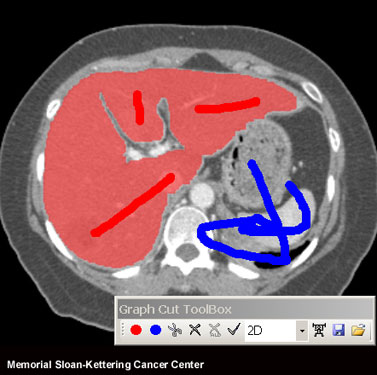News Release
SCIENCE HIGHLIGHTS of the 50th AAPM Meeting in Houston, July 27 to July 31
7. COMPUTER-AIDED ORGAN IDENTIFICATION

Example display of the software tool. The user trains the tool by
applying red and blue brush strokes to indicate liver and non-liver
regions. The tool calculates statistics from grey levels in the image to
identify the liver's outline (light red shaded area).
[Credit: Yu-Chi Hu /Memorial Sloan-Kettering Cancer Center]
Physicians and medical physicists often spend hours drawing lines around tumors and organs in CT images, causing a major bottleneck in cancer treatment. A new semi-automatic user-interface could reduce the time and fatigue associated with this meticulous task.
Radiation therapy begins with a CT scan in which 100 or so individual images (slices) are combined to create a 3D map of the region around the tumor. During the following segmentation step, all the organs and sensitive tissues must be identified and outlined for each slice, so that the medical physicist can plan a treatment that provides the highest dose to the target, while sparing the surrounding healthy tissue.
The resolution in CT scans is constantly increasing, which means more slices and more time required for segmentation. In addition, moving organs like the lung are starting to be scanned several times to form a time sequence. This can multiply by 10 the number of images an expert must analyze.
To help with this overwhelming load, Yu-chi Hu (huj@mskcc.org) and Gig Mageras of the Memorial Sloan-Kettering Cancer Center in New York, NY, along with Michael Grossberg of the City College of New York have developed a computer program that can segment organs with just a small amount of user input. Starting with one CT image, the user makes a crude outline of each organ. The computer takes this rough sketch and plugs it into a statistically-based algorithm, which it then uses to generate contours in subsequent images. The user checks the computer-drawn boundaries and can correct mistakes with tiny brushstrokes on the computer screen. These corrections are reincorporated by the software to better refine the algorithm.
With funding from the NIH, the team tested the user interface on several CT scans and found that on average an image could be segmented in roughly 6 seconds with the computer's help, instead of the 30 seconds or more in the unaided case. The researcher's algorithm correctly identified 98% of the image pixels, which was a higher precision than other contour-drawing algorithms that the researchers tested. The group is now planning to put the system into clinical use within 6 to 9 months.
Talk (TH-D-332-2), "Semi-Automatic Medical Image Segmentation with Adaptive Local Statistics in Conditional Random Field Framework" is at 1:42 p.m. on Thursday July 31, 2008 in Room 332. Abstract: http://www.aapm.org/meetings/amos2/pdf/35-9074-9005-850.pdf.
****************************************************************RELATED LINKS
- AAPM home page: http://www.aapm.org
- Abstracts and search form: http://www.aapm.org/meetings/08AM/MeetingProgram.asp
- Press Guide: http://www.aapm.org/meetings/08AM/VirtualPressRoom/
- Background article about how medical physics has revolutionized medicine:
http://www.newswise.com/articles/view/538208/
HOW TO COVER THE MEETING
Reporters who would like to attend the meeting in person should fill out the press registration form on the AAPM Virtual Press Room. See: http://www.aapm.org/meetings/08AM/VirtualPressRoom/documents/pressregform.pdf.
Reporters who would like to cover the conference remotely will find releases and articles on the Virtual Press Room highlighting many of the interesting and important talks presented at the meeting. Even if you can't make it to Houston, the Virtual Press Room will make it possible to write stories about the meeting from your desk.
ABOUT AAPM
The American Association of Physicists in Medicine (AAPM) is a scientific, educational, and professional nonprofit organization whose mission is to advance the application of physics to the diagnosis and treatment of human disease. The association encourages innovative research and development, helps disseminate scientific and technical information, fosters the education and professional development of medical physicists, and promotes the highest quality medical services for patients. In 2008, AAPM will celebrate its 50th year of serving patients, physicians, and physicists. Please visit the association's Web site at http://www.aapm.org/.
ABOUT AIP
Headquartered in College Park, MD., the American Institute of Physics is a not-for-profit membership corporation chartered in New York State in 1931 for the purpose of promoting the advancement and diffusion of the knowledge of physics and its application to human welfare.
####
Media contacts:
Jason Socrates Bardi, American Institute of Physics,
301-209-3091 (office) 858-775-4080 (cell)
jbardi@aip.org
Jeff Limmer, AAPM Media Relations Subcommittee Chair
jeffl@aspirus.org
